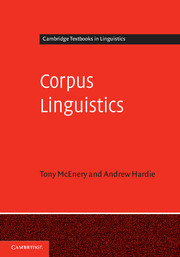Book contents
- Frontmatter
- Contents
- List of figures
- List of tables
- Acknowledgements
- Preface
- 1 What is corpus linguistics?
- 2 Accessing and analysing corpus data
- 3 The web, laws and ethics
- 4 English Corpus Linguistics
- 5 Corpus-based studies of synchronic and diachronic variation
- 6 Neo-Firthian corpus linguistics
- 7 Corpus methods and functionalist linguistics
- 8 The convergence of corpus linguistics, psycholinguistics and functionalist linguistics
- 9 Conclusion
- Glossary
- Notes
- References
- Index
1 - What is corpus linguistics?
Published online by Cambridge University Press: 05 June 2012
- Frontmatter
- Contents
- List of figures
- List of tables
- Acknowledgements
- Preface
- 1 What is corpus linguistics?
- 2 Accessing and analysing corpus data
- 3 The web, laws and ethics
- 4 English Corpus Linguistics
- 5 Corpus-based studies of synchronic and diachronic variation
- 6 Neo-Firthian corpus linguistics
- 7 Corpus methods and functionalist linguistics
- 8 The convergence of corpus linguistics, psycholinguistics and functionalist linguistics
- 9 Conclusion
- Glossary
- Notes
- References
- Index
Summary
Introduction
What is corpus linguistics? It is certainly quite distinct from most other topics you might study in linguistics, as it is not directly about the study of any particular aspect of language. Rather, it is an area which focuses upon a set of procedures, or methods, for studying language (although, as we will see, at least one major school of corpus linguists does not agree with the characterisation of corpus linguistics as a methodology). The procedures themselves are still developing, and remain an unclearly delineated set – though some of them, such as concordancing, are well established and are viewed as central to the approach. Given these procedures, we can take a corpus-based approach to many areas of linguistics. Yet precisely because of this, as this book will show, corpus linguistics has the potential to reorient our entire approach to the study of language. It may refine and redefine a range of theories of language. It may also enable us to use theories of language which were at best difficult to explore prior to the development of corpora of suitable size and machines of sufficient power to exploit them. Importantly, the development of corpus linguistics has also spawned, or at least facilitated the exploration of, new theories of language – theories which draw their inspiration from attested language use and the findings drawn from it. In this book, these impacts of corpus linguistics will be introduced, explored and evaluated.
Before exploring the impact of corpora on linguistics in general, however, let us return to the observation that corpus linguistics focuses upon a group of methods for studying language. This is an important observation, but needs to be qualified. Corpus linguistics is not a monolithic, consensually agreed set of methods and procedures for the exploration of language. While some generalisations can be made that characterise much of what is called ‘corpus linguistics’, it is very important to realise that corpus linguistics is a heterogeneous field. Differences exist within corpus linguistics which separate out and subcategorise varying approaches to the use of corpus data. But let us first deal with the generalisations. We could reasonably define corpus linguistics as dealing with some set of machine-readable texts which is deemed an appropriate basis on which to study a specific set of research questions. The set of texts or corpus dealt with is usually of a size which defies analysis by hand and eye alone within any reasonable timeframe. It is the large scale of the data used that explains the use of machine-readable text. Unless we use a computer to read, search and manipulate the data, working with extremely large datasets is not feasible because of the time it would take a human analyst, or team of analysts, to search through the text. It is certainly extremely difficult to search such a large corpus by hand in a way which guarantees no error. The next generalisation follows from this observation: corpora are invariably exploited using tools which allow users to search through them rapidly and reliably. Some of these tools, namely concordancers, allow users to look at words in context. Most such tools also allow the production of frequency data of some description, for example a word frequency list, which lists all words appearing in a corpus and specifies for each word how many times it occurs in that corpus. Concordances and frequency data exemplify respectively the two forms of analysis, namely qualitative and quantitative, that are equally important to corpus linguistics.
- Type
- Chapter
- Information
- Corpus LinguisticsMethod, Theory and Practice, pp. 1 - 24Publisher: Cambridge University PressPrint publication year: 2011
- 5
- Cited by

